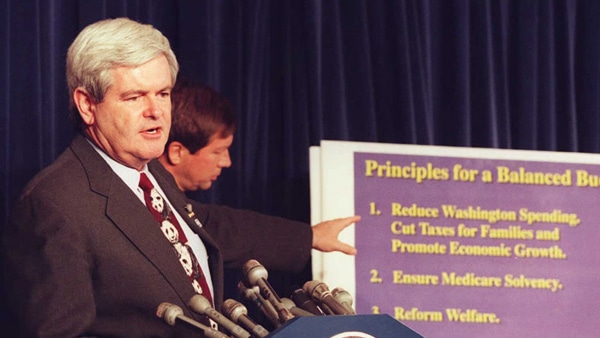After a 20-year detour, it is time to get back to a balanced budget and pay down the national debt.
With the debt ceiling being reached, it is clear we must increase in the amount of money the United States Government can legally borrow.
President Joe Biden and most Democrats have taken the position that we should increase the spending limit with no changes, modifications, or reforms.
Republicans – and Democrat Sen. Joe Manchin – have said it would be irresponsible to simply extend the government’s ability to run up more debt without curbing spending. Specifically, any debt ceiling increase should be done in a responsible way, with serious reforms to the pattern of government spending, that will move us back toward a balanced budget by 2033.
The sheer weight of the interest on our growing debt should convince anyone concerned about America’s future that the Republicans and Manchin are right.
According to the May 2022 Congressional Budget Office report the United States is going to add $16 trillion to the national debt between now and 2033 (I’m sure it’s much higher now). That additional deficit spending will give the United States a debt 109 percent bigger than the projected gross domestic product that year.
Under the current uncontrolled spending pattern, by 2029 paying interest on the national debt will cost more than the entire defense budget. By 2033, America will be spending $196 billion more on interest payments than on our national security ($1,194 billion in interest versus $998 billion in national security). In fact, payments on interest will almost equal all domestic discretionary spending by 2033.
According to the CBO, all this debt will drive up interest rates – which will of course further drive up interest payments. It currently projects three–month U.S. bonds will jump nearly 400 percent from (0.6 percent to 2.3 percent) and 10-year U.S. bonds will jump 80 percent (2.1 percent to 3.8 percent). This crushing interest will be borne by taxpayers.
Further, the debt and interest rate interaction creates a vicious cycle. The more you borrow, the more pressure there is for inflation. The more inflation, the higher interest rates get. Higher interest rates mean bigger interest payments on the debt.
This cycle of government demanding money to cover its deficits also crowds out capital for the private sector – and ultimately weakens economic growth and jobs. We have watched the European welfare state system for 70 years. It has crowded out economic growth and increased unemployment and underemployment. We’ve seen downward cycles of bigger welfare states transferring more money from taxpayers to those who cannot find work – and thus increasing the number of unemployed. (In some cases, European countries have bailed out their neighbors and only made problems worse.)
I know it is possible to balance the budget because we have done it before. When I was Speaker of the House, we began negotiations with Democrat President Bill Clinton which led to the only four consecutive balanced budgets in our lifetime.
The American people intuitively understand that the current deficit spending machinery of big government is unsustainable. In a new poll, Scott Rasmussen reports that only 27 percent (only one-fourth) of Americans favor raising the debt ceiling with no spending cuts.
By contrast, according to Rasmussen, 73 percent believe it is reasonable to cut spending – and by 62 percent to 36 percent Americans favor modest cuts in all agencies. There are no sacred cows.
Every dollar we save is a deficit dollar we will not have to pay interest on in perpetuity.
The path forward is clear – and required for our survival.
First, we must get spending under control. Second, we must get to a balanced budget. Third, we must sustain the balance and start paying down the national debt.
When I left the speakership, the projections indicated we could pay off the national debt. On April 27, 2001, then-U.S. Federal Reserve Chairman Alan Greenspan told the Bond Market Association:
“While the magnitudes of future federal unified budget surpluses are uncertain, they are highly likely to remain sizable for some time. The dramatic improvement in projections of the budget balance in recent years …current forecasts suggest that under a reasonably wide variety of possible tax and spending policies, the resulting surpluses will allow the Treasury debt held by the public to be paid off.”
After a 20–year detour, it is time to get back on the road to a balanced budget and pay down the national debt.
A responsible debt ceiling with reasonable reductions in spending and reform in government incompetence and inefficiency is the right place to start.
Every concerned American should demand that their congressman and senators insist on a responsible debt ceiling increase and reject an irresponsible continuation of spending with no reforms.
For our nation’s future, it is imperative that we develop a controlled process of profound reform that will lead us to a balanced budget by 2033. Otherwise, the following decade could be a disaster.

Newt’s Latest Articles:
- Speaker Mike Johnson Is Doing An Excellent Job
- Enjoying Life by Enjoying Nature this Earth Day
- Biden and the ‘Blame America First’ Democrats
- Communist China Claims All Pandas in the World, Which Illuminates a Larger Story
- The American People vs. Judicial Corruption
Newt’s Latest Podcasts:
- Newt’s World – Episode 687: Reforming the Criminal Justice System

- Newt’s World – Episode 686: Iran Attacks Israel
- Newt’s World – Episode 685: Welfare Reform

- Newt’s World – Episode 684: Funding the War in Ukraine

- Newt’s World – Episode 683: Student Loan Debt Forgiveness

Get Newt’s Latest Book:








